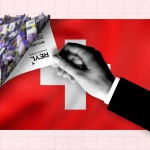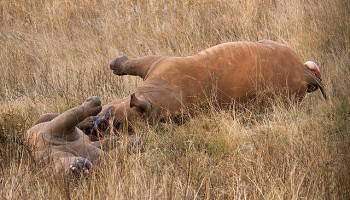The owner laughed when confronted with the dead lions that had burned alive on his run-down farm. Flames had engulfed the ranch, Olivia Lodge, as wildfires spread through South Africa’s Free State province in September last year, leaving a trail of devastation behind.
Lion corpses littered the charred ground, while the animals that had survived the fires lay nearby, too weak to move, pictures and videos showed. The lions and tigers kept in the farm’s barren enclosures were diseased and malnourished, some so desperate they had resorted to cannibalism. More than 30 had to be euthanized, in what an inspector described as one of the most extreme cases of animal cruelty South Africa had ever seen.
“This is common for breeders who kill their lions for profit and do not need to raise them in a healthy condition,” said Reinet Meyer, a senior inspector with the Society for the Prevention of Cruelty to Animals (SPCA) in Bloemfontein, the capital of the Free State.
South Africa has the world’s only commercial lion-farming industry, where animals are bred for petting zoos, trophy hunting — or for their teeth, claws, and bones. There is no official data on how many are kept on private ranches, but at least two independent studies found they held over 7,800 lions, more than three times the country’s wild population.
While the farms operate in a legal gray area, they feed an international black market for big cat bones that is pushing species such as lions and tigers to the brink of extinction. The skeletons of captive-bred lions are traded by the same organized crime syndicates that traffic in banned products like ivory and rhinoceros horn, as part of the multi-billion-dollar global illegal wildlife trade.
“The bone trade is highly profitable, very secretive, and destroys the very essence of these animals,” said Meyer, from the SPCA. “It is criminal.”
The owner of Olivia Lodge said he no longer bred lions and the farm had been shut down. “Those lions weren’t even my lions,” he told a reporter, claiming that they “belonged to someone else.”
OCCRP followed the trail of this clandestine industry, from the horrors of the captive breeding facilities to the criminals in Asia who profit.
Export records from South Africa’s largest airport showed that nearly half the lion bones shipped abroad between 2016 and 2019 were sold to the Southeast Asian nation of Laos, long known as a hub of the illegal wildlife trade. Most of these bones were bought by shell companies connected to one of the world’s most notorious wildlife trafficking groups, the Laos-based Xaysavang Network.
Nearly all the bones were sold by a handful of South African brokers and taxidermists, including one that was named as supplying the Xaysavang Network more than a decade ago. A 2018 report by non profits Ban Animal Trading and EMS Foundation delved further into these networks, highlighting key brokers and importers.
When a researcher tried to visit the top bone buyers in Laos — most of which are registered close to the home of the network’s leader, a man known as the “Pablo Escobar of wildlife trafficking” — they found no trace that the companies even existed. Often, the lion bones appear to have been quietly rerouted from Laos to Vietnam.
Today, the future of South Africa’s lion farming industry is in limbo. In 2017, the environment ministry brought in annual quotas limiting the number of skeletons that could be exported from the country.
After an animal charity challenged the legality of the exports altogether, the High Court ruled in 2019 that they were unconstitutional because they did not account for the lions’ welfare. Since then, the government has stopped issuing export quotas, effectively placing a moratorium on the bone trade.
But the legality of lion bone exports is disputed even among South African government bodies.
The environment ministry told OCCRP that it has considered lion bone exports to be illegal since the 2019 ruling. But the South African Revenue Service, which oversees the country’s customs, said it had never been notified by the ministry that lion bone exports were illegal. It said customs officers were not monitoring bone exports, other than making sure that each shipment had an export permit and that they were clean.
”The bone trade is highly profitable, very secretive, and destroys the very essence of these animals.”
Reinet Meyer
Senior Inspector, Society for the Prevention of Cruelty to Animals
In a follow-up statement, the revenue service said it works with the environment ministry “on a continuous basis” to ensure that controls and enforcement actions” are taken. "Where discrepancies are highlighted, controls will be put in place,” it added.
Faced with mounting political pressure, South Africa’s environment minister announced last year that the government would shut down the captive breeding industry entirely. Yet the lion farms continue to operate, and the future of thousands of animals held inside them is unclear.
The Breeders
South Africa’s lion farming industry started in the 1990s, when the first trophy hunters arrived looking for animals to kill on highly choreographed “canned hunting” trips, like those reportedly favored by the sons of former U.S. President Donald Trump. The industry has grown rapidly since then: Last year the environment ministry said there were 260 captive-breeding facilities, despite the moratorium on exporting lion bones.
Over the past decade or so, farmers have shifted to breeding lions and other big cats for their skeletons, which are prized in traditional Chinese medicine as an aphrodisiac or a remedy for injuries. While scientists say there is no evidence for these claims, demand for “bone wine,” made from powdered bones mixed with herbs and alcohol, remains high among wealthy Chinese.
Animal rights activists say that because most of South Africa’s lions are now bred for their bones, there is little incentive to keep them healthy while they are alive. State authorities are meant to monitor the animals’ welfare, but investigations by the media and nonprofits have revealed a litany of abuse behind closed doors.
In March, SPCA inspectors found lions living in “horrific” conditions on one of the largest farms in the Free State province, the epicenter of South Africa’s lion breeding industry. Pictures from two visits they made to the ranch, called Mooifontein, show animals with protruding ribs held in filthy, crowded enclosures littered with rotting bones and feces. Bones and body parts were found stashed around the property, the products of unreported deaths, one of the inspectors noted in a report on the visit.
Dean Loser, who owns Mooifontein, did not reply to requests for comment.
The environment ministry said that oversight of lion farms fell to local authorities and it was not the ministry’s responsibility to investigate who was behind the bone trade. The Free State provincial government told OCCRP to file an access for information request, then stopped responding to questions.
After a lobbying campaign against the lion farming industry by animal welfare activists, South Africa capped the number of skeletons that could be legally exported at 800 in 2017. The following year, the environment ministry briefly raised the annual export quota to 1,500, though this was reduced again after a damning Parliamentary report called for an end to captive breeding altogether.
Perversely, however, business seems to have boomed on the Free State’s lion farms after the export cap was brought in. Breeding permits indicate the number of new cubs born nearly tripled in just two years, rising from 1,188 in 2017 to 3,200 in 2019, the year legal exports stopped.
SJ Alberts, who has spent more than 40 years working in the lion farming industry, said breeding for bones took off after the collapse of the canned hunting market led to a plummet in the price of live animals.
“I believe that the first mass euthanasia permits were issued around 2016,” said Alberts. “Some breeders saw the writing on the wall for the captive breeding industry. Suddenly the ... value of thousands of animals existed only in their bones.”
He said Asian customers preferred the skeletons of euthanized lions because they were “fresh,” and “hunted skeletons generally were badly damaged … with many broken bones that affected the price greatly.”
Lions typically take around three years to raise to maturity, so there are now thousands of animals old enough to slaughter whose bones cannot be legally exported. Peter Bishop, a South African organized crime consultant with 30 years’ experience investigating wildlife trafficking, said the fact that breeding continued to rise after exports were capped shows that farmers still expected to sell their lion bones abroad.
“The [permit] numbers show that breeding increased from 2017 when the quota was set,” said Bishop.
“They knew, perhaps from advance orders, that foreign buyers were lined up or it would be a massive financial loss. They cannot be working in the dark or selling to a spontaneous market, given the costs involved.”
The Brokers
Some Free State breeders killed their lions on their own properties, but others sent animals to larger facilities to be slaughtered, transport permits show.
Nightmarish images from a 2018 SPCA inspection of Wag n Bietjie, a major abattoir in the Free State, show stripped carcasses and body parts strewn across the floor. Often lions were kept for days in tiny cages near where others were being slaughtered.
“The cruelty was unbearable to witness,” said Meyer, from the SPCA.
A source with knowledge of how Wag n Bietjie operated, who asked not to be named, said that conditions on the farms were brutal. "The lions were shot through the ear and then skinned. This was mostly done on the property,” said the source. Once the animals were butchered, their bones were picked up and sent to buyers in Asia, they added.
The conditions were so horrendous that Wag n Bietjie was shut down by a court order this year. Its owner did not respond to requests for comment.
Once dead, the lions’ bones were shipped abroad by brokers and taxidermists. These middlemen play a key role in the wildlife trafficking supply chain, obtaining trading permits, as well as processing animal parts for export. Some also act as conduits of trafficked wildlife from other countries such as Zimbabwe, Namibia, and Mozambique, which are sent for “finishing” in South Africa, where they can be legally re-exported.
A handful of brokers and taxidermists have dominated the lion bone trade for years, according to export data from O.R. Tambo International Airport in Johannesburg. Between 2014 and 2019, just five companies accounted for almost all of the recorded bone exports through the airport, between them shipping more than 3,500 skeletons. More than 1,000 were shipped in 2017 alone, the airport data shows, well above the government’s quota of 800 for that year.
Sandra Linde Taxidermy exported more than 1,150 lion skeletons and carcasses from 2016 through 2019, making it the top bone trader during that period. In 2011, the company was named by the environment ministry as supplying the Xaysavang Network in South Africa’s National Assembly, yet it remains a major exporter of animal parts to this day.
Sandra Linde kept exporting lion bones even after the High Court’s ruling that they were illegal in August 2019. The following month, the company sent two shipments to Vietnam together containing more than 30 skeletons, the export records show. Both were given special permit codes, indicating they may have been specifically approved for export.
Sandra Linde’s owner declined to comment, then seemingly blocked the reporter’s number. A person who answered the phone when OCCRP called Sandra Linde said the company operated within the law and threatened legal action over any negative coverage.
Bishop, the organized crime investigator, said the other major brokers named in the export data had been on law enforcement’s radar for trading in rhino horn, but their lion bone exports were not monitored as they weren’t technically illegal.
“There was no active monitoring about the nexus between organized crime financing the bone industry and the role of the local suppliers,” he said.
Andries Van Tonder and Gavin Oberholzer did not respond to questions sent by OCCRP. Gavin De Jager declined to comment. Alberts said he only exported lion bones from 2016 to 2018, and always operated within the law.
“I realize that the lion bone trade is repulsive to most people and I am not going to justify my involvement. All I can say is if I had the choice to do it over, I probably would not have gotten involved,” he said.
The Airport
O.R. Tambo, in Johannesburg, is the busiest airport in Africa. Before the COVID-19 pandemic, 21 million people passed through it every year, along with millions of tons of cargo destined for countries around the world.
For years, it was also a key hub in South Africa’s trade in lion bones. Export certificates, invoices, and customs documents show over 3,700 skeletons officially passed through the airport between 2016 and 2019. This included almost 1,900 exported in 2016 alone — close to the entire population of wild lions in South Africa today.
But even these figures appear to vastly underestimate the true scale of the country’s lion bone export industry.
Paperwork filed at O.R. Tambo priced the lion skeletons at between $50 and $100 apiece, but other documents accompanying the shipments show their true value was between $1,250 and $2,150 each, depending on whether the skull was included. While all the skeletons exported in 2017 were valued at between $31,000 and $62,000, according to export data, in reality they would have been worth $1.1 million to $1.9 million.
“Under-invoicing did take place. There was no financial benefit for the exporter, but [it] was a requirement by the seller,” said Alberts, the lion bone industry veteran.
Many of the shipments seem to have been packed with more bones than they declared, a classic technique used by smugglers. For example, the paperwork for one shipment that was destined for Thailand in October 2017 said it contained 37 skeletons. But the weight of the shipment is variously listed as between 698 and 950 kilograms. Based on the average weight of lion bones, this indicates it actually contained between 41 and 93 skeletons.
Export permits for more than 50 of the shipments were used at least twice, many of them well past their expiration date, another sign that South Africa exported far more lion bones than officially recorded — and far more than allowed.
"Artificially reducing the financial value, weight, or number of skeletons to pack in more are tactics used by brokers to maximize and hide profit," said Smaragda Louw from Ban Animal Trading, a South African animal rights nonprofit that was instrumental in lobbying for the end of the lion bone trade.
The details listed for the buyers and sellers were also riddled with irregularities. Three of the major South African brokers list the same address, which belongs to a former Thai massage parlor turned fast-food joint on the outskirts of Johannesburg.
Two of the Laotian importers, Vannaseng and Vinasikhone, shipped lion bones via O.R. Tambo even after both of the companies were named in the Guardian newspaper as major traffickers of protected wildlife in 2016, the export records show.
Alberts, the lion industry veteran, said that when he had bones to export he would text an agent, who would give him the names of buyers to apply for export permits. “In my opinion these were all shell companies,” he said.
South Africa’s revenue service said it was not practical for customs to scan all exports, and officers’ only duties were to check that shipments had the necessary permits and didn’t contain rotten flesh or maggots. A spokesperson added that airlines were responsible for screening goods under rules laid out by international bodies that oversee the aviation industry.
A spokesperson for O.R. Tambo airport did not respond to a request for comment.
Nearly all of the lion bones that left the airport were transported by South African private carrier Airline Express. The carrier’s manager, Justus Britz, said it never questioned any of the details listed for the shipments.
“We assumed everything was in order,” he said.
The Buyers
Only a few minutes’ brisk walk separates the nondescript addresses where four of the top buyers of South Africa’s lion bones are registered. All are located in Paksan, a town in western Laos on the border with Thailand that is known as the home of the Xaysavang Network.
It was here that the group’s leader, Vexay Keosavang, first started the Xaysavang Trading Company in the 2000s. Since then the company has been implicated in the smuggling of thousands of animal parts from Africa and Asia, including endangered species such as pangolins, tigers, and rhinos. The network is so prolific that the U.S. government is offering a $1 million reward for information that helps bring it down.
Just outside Paksan sits a large compound where Keosavang himself was reported to live. Multiple investigations by journalists and intelligence officers have tracked Keosavang to this address — and locals said it is an open secret that he spent the COVID-19 pandemic holed up here — yet he has never been accused of a crime in Laos due to his political connections, according to The Guardian. Reporters were unable to reach him for comment.
Steve Galster, head of Asia investigations for the Freeland Foundation, a nonprofit that fights wildlife trafficking, said the Xaysavang Network used the legal trade in lion bones to mask its dealings in other protected species, like tigers and rhinos. “Watching Vexay operate for many years made me realize that the biggest threat to wildlife is the legal wildlife trade,” he said.
Most of the major Laotian lion bone buyers list addresses in Paksan in their South African paperwork, three of them on the street where Xaysavang Trading was first registered. But when a researcher tried to visit them, they found only residential homes, apartments, or other businesses. OCCRP tried to reach all of the companies for comment, but emails went unanswered and their phone numbers were out of service or went to voicemail.
Five Laotian companies bought the majority of lion bones exported through O.R. Tambo airport between 2014 and 2016, the data showed. On paper, the companies are all separate entities, but reporters found links that indicate they are connected to the Xaysavang Network.
One was Vannaseng, which was named as trafficking protected species into Laos in 2016. Investigations by the Freeland Foundation found that Vannaseng and another of the Laotian lion bone traders, Vinasikhone, took over the Xaysavang Network’s trafficking routes in Vietnam, Thailand, and Laos after the cartel became too high-profile. Louw said she had seen export records showing that Keosavang received lion bones from South Africa at Vannaseng’s address in Paksan in 2016.
South Africa’s environment ministry would not confirm how many lion bones were shipped to Vannaseng and Vinasikhone when pressed by OCCRP. However, unprompted, the ministry did provide data relating to two other companies that appear to be connected to the Xaysavang Network.
One was Ainthaphone, which lists the same contact number as Vannaseng, both in the export paperwork and online. The ministry said Ainthaphone was granted permits to buy more than 500 kilograms of lion bones from South Africa in 2016-2017, though the O.R. Tambo records show the total may be seven times that. In paperwork for the shipment, Ainthaphone gives an address at the international airport in Laos’ capital — as did another of the top lion bone buyers, Lilavady, before it moved to the address of a corporate gift shop.
”Watching Vexay operate for many years made me realize that the biggest threat to wildlife is the legal wildlife trade.”
Steve Galster
Head of Asia Investigations, the Freeland Foundation
According to South Africa’s environment ministry, Laotian company Somaok Phaimany also received 2,600 kilograms of lion bones in 2017 and 280 kilograms more in 2019. But when a researcher visited the address it listed, which is on the same street in Paksan as Xaysavang Trading, they found only a small, run-down residential property.
Another of the main lion bone buyers, Development Agriculture, said it operated from a garage on the same street, as well as in a factory just outside Paksan. One of the company’s representatives is the wife of major South African broker Van Tonder, who last year was reportedly arrested for illegally keeping $155,000 worth of lion bones without proper permits.
Van Tonder and another of the major brokers also exported dozens of skeletons to a company called Lisa Lion, which gave one address in Thailand and another that appeared to be in a travel agency in Laos. One of the company’s representatives is Sebastian Rothman, a South African who was previously outed as supplying the Xaysavang Network. He did not reply to a request for comment.
On paper, these companies were major importers of South Africa’s lion skeletons from 2014 to 2019. But other data shows they never actually received a single bone.
According to export permits issued in South Africa under the Convention on International Trade in Endangered Species (CITES), which regulates the global wildlife trade, over 1,600 skeletons were shipped to Laos between 2014 and 2019. However, Laos’ customs never recorded any of the imports. Instead, data in the U.N. Comtrade Database indicate they were rerouted to neighboring Vietnam, where the Xaysavang Network is also thought to operate.
In 2017, Vietnamese customs recorded receiving nine shipments together containing over 520 lion skeletons from South African brokers worth over $142,000, though some of them were recorded as coming via other countries. By 2019 — the year South Africa stopped issuing export quotas for lion bones, effectively placing a moratorium on the trade — this had surged to 28 shipments valued at over $378,000.
As in Laos, the Vietnamese buyers seem unlikely lion bone traders, and were variously described as working in finance, construction, and beverage trading. There also appear to be huge disparities in trade data: In one case, South Africa recorded exporting 30 skeletons, while Vietnam said the shipment contained 273. In several cases, the same companies were listed importing lion bones in both Laos and Vietnam or Thailand in different years.
"Vietnam is a main receiver in practice, but on paper it is Laos issuing the permits without recording any imports,” said Louw from Ban Animal Trading. Traders “hide behind CITES permits that are easily manipulated and fraudulently used by organized crime,” she added.
CITES authorities in Laos and Vietnam did not respond to requests for comment. The CITES Secretariat, in Geneva, said that it was not responsible for monitoring the specifics of the lion bone trade, which is left to authorities in signatory states and government-appointed CITES experts.
OCCRP was unable to reach any of the Vietnamese companies named in the data for comment.
After being exported to Southeast Asia, most of South Africa’s lion bones are thought to end up in China, where bone stock is brewed into supposed “health wines” and sold at an astonishing mark-up.
Between two and four grams of tiger or lion bone powder is used for every liter of wine. While high-end brands used to command tens of thousands of dollars, today they sell for an average of between $70 and $140 a bottle. Even using the highest value for a lion skeleton in the South African export data, this indicates a profit margin of well over 90 percent.
"The profitability of this trade is exorbitant and it finances a vast criminal underworld," said Louw. "South Africa allowed organized crime to profit without accountability or fear of being caught. The time has come to end it."











